Fix Windows Modules Installer Worker High CPU Usage
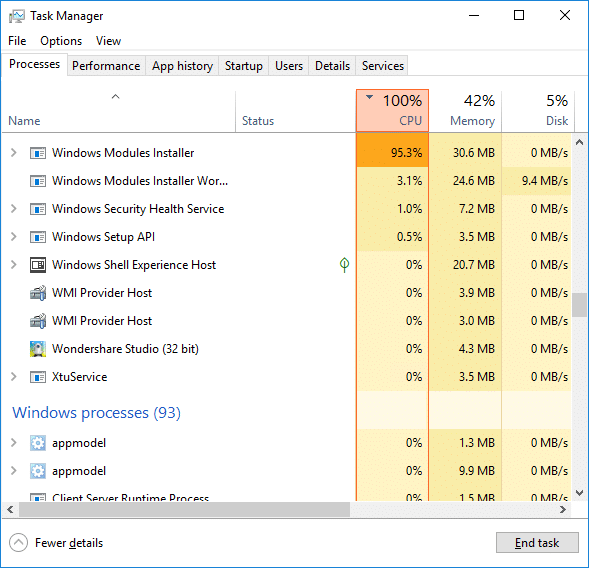
If you are facing the High CPU Usage by Windows Modules Installer Worker, then don’t worry as thousands of other users are also facing the similar problem and therefore, there are many working fixes which we will be discussing today in this article. To verify if you are facing this issue open Task Manager (Ctrl + Shift + Esc) and you will find that the Windows Modules Installer Worker is consuming High CPU or Disk Usage.

Pro Tip: You may leave your PC overnight or for a few hours to see the issue rectify itself once the Windows is finished downloading and installing updates.
What is Windows Modules Installer worker (WMIW)?
Windows Modules Installer worker (WMIW) is a service which takes cares of automatically installing Windows Update. According to its service description, WMIW is a system process that enables automatic installation, modification, and removal of Windows updates and optional components.
This process is responsible for finding new Windows Update automatically and installing them. As you might be aware that Windows 10 automatically install newer builds (i.e. 1803 etc.) via Windows Updates, so this process is responsible for installing these updates in the background.
Although this process is called Windows Modules Installer worker (WMIW) and you will see the same name in the Processes tab in the Task Manager, but if you switch to Details tab, then you will find the name of the file as TiWorker.exe.
Why Is Windows Modules Installer worker Using So Much CPU?
As Windows Modules Installer worker (TiWorker.exe) runs continuously in the background, sometimes it might utilize high CPU or disk usage when installing or uninstalling Windows Updates. But if its constantly using high CPU then the Windows Modules Installer worker may have become unresponsive while checking new updates. As a result, you may be experiencing lags, or your system might hang or freeze completely.
The first thing users do when they experience freezing, or lagging issues on their system is to restart their PC, but I assure you that this strategy won’t work in this case. This is because the issue will not resolve by itself until and unless you fix the underlying cause.
Fix Windows Modules Installer Worker High CPU Usage
Priksa manawa sampeyan nggawe titik mulihake yen ana sing salah.
Windows Modules Installer Worker (WMIW) is an important service, and it should not be disabled. WMIW or TiWorker.exe is not a virus or malware, and you cannot just delete this service from your PC. So without wasting any time let’s see How to Fix Windows Modules Installer Worker High CPU Usage kanthi bantuan saka pandhuan ngatasi masalah ing ngisor iki.
Cara 1: Jalanake Windows Update Troubleshooter
1. Pencet Windows Key + I kanggo mbukak Setelan banjur klik Ikon Update & Keamanan.
![]()
2. Saka menu kiwa, pilih troubleshoot ing "Bangun lan mlaku"klik ing Update Windows.

3. Saiki klik "Jalanake masalah kasebut"ing Windows Update.
4. Let the troubleshooter run, and it will automatically fix any issues found with Windows Update taking forever.
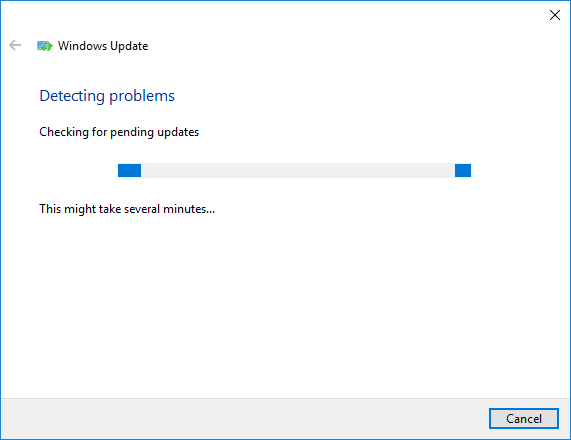
Method 2: Manually Check for Windows Updates
1. Pencet Windows Key + I banjur pilih Nganyari & Keamanan.
2. Saka sisih kiwa, menu klik ing Update Windows.
3. Saiki klik ing "Priksa pembaruan"tombol kanggo mriksa nganyari sing kasedhiya.

4. Yen ana nganyari sing ditundha, banjur klik ing Ngundhuh & Instal nganyari.

5. Sawise nganyari wis diundhuh, nginstal, lan Windows bakal dadi up-to-date.
Method 3: Configure Windows Update to Manual
Ati-ati: This method will switch Windows Update from automatically installing the new updates to the manual. This means you have to manually check for Windows Update (weekly or monthly) to keep your PC secure. But follow this method, and you can again set the Updates to Automatic once the issue is resolved.
1.Pencet Windows Key + R banjur ketik layanan.msc lan tekan Enter.

2. Scroll down and find Instalasi Windows Modul service in the list.
3. Klik-tengen ing Layanan Instalasi Modul Windows Lan pilih Properties.
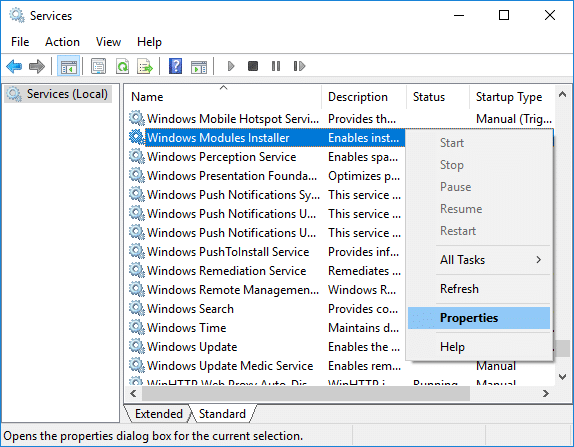
4. Saiki klik ing mungkasi then from the Tipe pambuka drop-down select Manual.
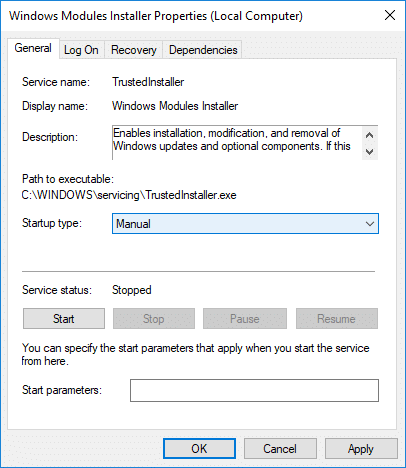
5. Klik Apply, ngiring dening OK.
6. Similarly, follow the same step for the Windows Update service.

7. Urip maneh PC kanggo nyimpen owah-owahan.
8. Maneh mriksa kanggo Windows Updates Manually lan nginstal nganyari sing ditundha.
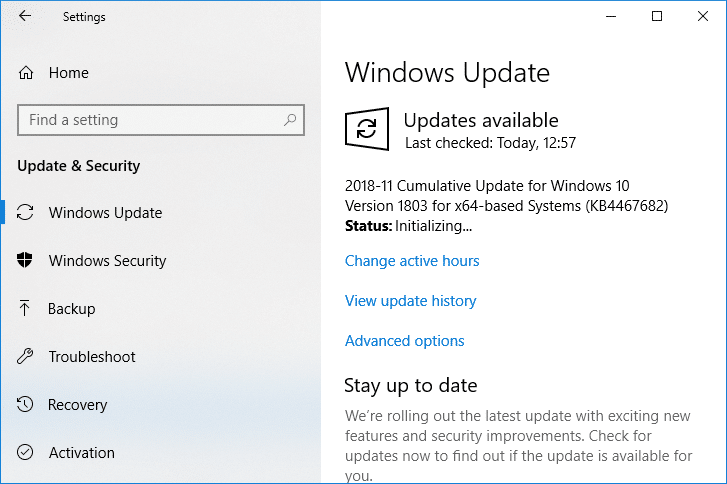
9. Once is done, again go back to services.msc window and open the Windows Modules Installer & Windows Update Properties jendhela.
10. Setel ing Tipe pambuka kanggo otomatis lan klik Mulai. Then click Apply followed by OK.
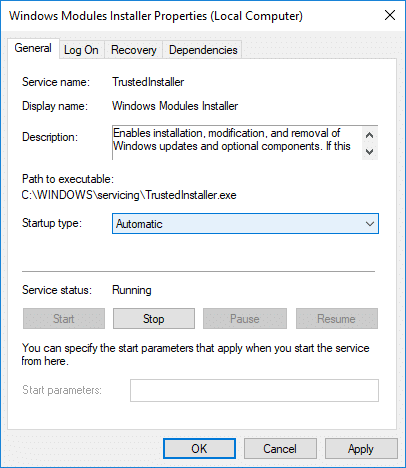
11. Urip maneh PC kanggo nyimpen owah-owahan.
Cara 4: Run System Maintenance Troubleshooter
1. Pencet Windows Key + R banjur ketik kontrol lan pencet Enter kanggo mbukak Panel Kontrol.

2. Telusuri Troubleshoot banjur klik ing Ngatasi masalah.

3. Sabanjure, klik Delok Kabeh ing sisih kiwa.
4. Klik ing “System Maintenance” kanggo mbukak ing System Maintenance Troubleshooter.

5. Troubleshooter bisa uga Fix Windows Modules Installer Worker High CPU Usage, but if it didn’t, then you need to run System Performance Troubleshooter.
6. Bukak Command Prompt. Pangguna bisa nindakake langkah iki kanthi nggoleki 'cmd' Banjur pencet Ketik.

7. Ketik printah ing ngisor iki menyang cmd banjur pencet Ketik:
msdt.exe / id PerformanceDiagnostic
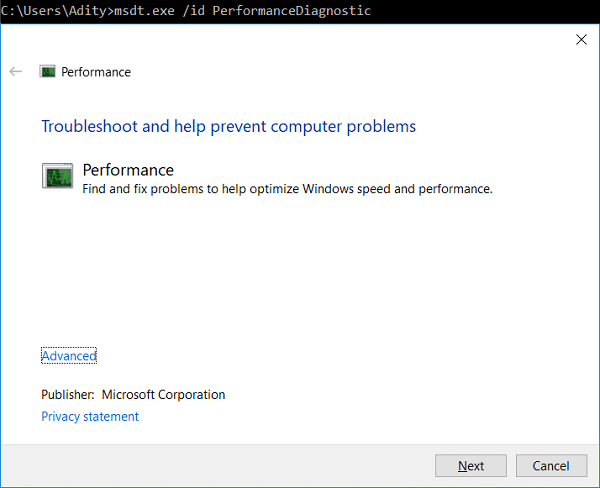
8. Follow the on-screen instruction to run the troubleshooter and fix any issues find the System.
9. Finally, exit the cmd and reboot your PC.
Method 5: Disable Automatic Maintenance
Sometimes Automatic Maintenance can conflict with the Windows Modules Installer Worker service, so try to disable Automatic Maintenance using this guide and see if this fixes your issue.
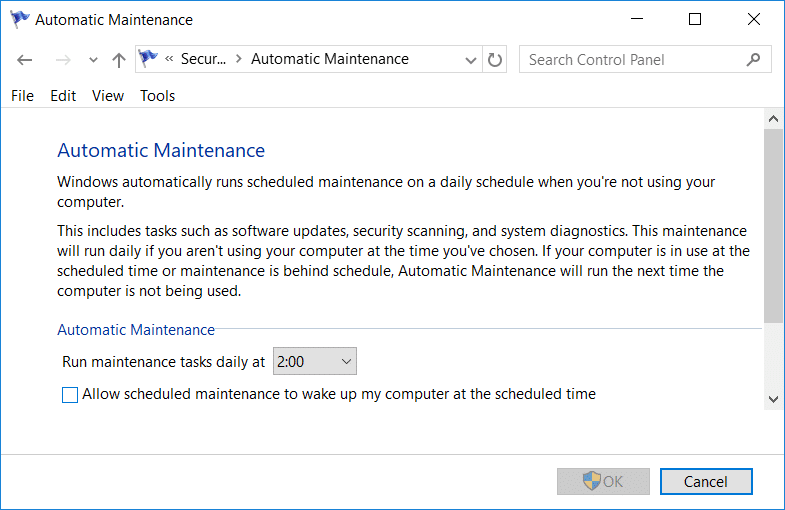
Although disabling Automatic Maintenance is not a good idea, but there might be some case where you need to actually disable it, for example, if your PC freezes during automatic maintenance or Windows Modules Installer Worker High CPU Usage issue then you should disable maintenance to troubleshoot the issue.
Method 6: Run System File Checker and DISM
1. Bukak Command Prompt. Pangguna bisa nindakake langkah iki kanthi nggoleki 'cmd' Banjur pencet Ketik.
2. Saiki ketik ing ngisor iki ing cmd lan tekan enter:
Sfc /scannow sfc /scannow /offbootdir=c: /offwindir=c:windows (Yen ing ndhuwur gagal banjur coba iki)

3. Enteni proses ing ndhuwur rampung lan yen wis rampung, miwiti maneh PC.
4. Bukak maneh cmd banjur ketik printah ing ngisor iki banjur pencet enter sawise saben:
Dism /Online /Cleanup-Image /CheckHealth Dism /Online /Cleanup-Image /ScanHealth Dism /Online /Cleanup-Image /RestoreHealth

5. Ayo printah DISM mlaku lan ngenteni nganti rampung.
6. Yen printah ing ndhuwur ora bisa, banjur nyoba ing ngisor iki:
Dism /Gambar:C:offline /Cleanup-Image /RestoreHealth /Sumber:c:testmountwindows Dism /Online /Cleanup-Image /RestoreHealth /Sumber:c:testmountwindows /LimitAccess
Catetan: Ganti C: RepairSourceWindows nganggo sumber ndandani (Instalasi Windows utawa Disk Recovery).
7. Urip maneh PC kanggo nyimpen owahan lan weruh yen sampeyan bisa Fix Windows Modules Installer Worker High CPU Usage.
Cara 7: Nindakake Boot Clean
Sometimes 3rd party software can conflict with Windows and can cause the issue. To Fix Windows Modules Installer Worker High CPU Usage issue, sampeyan kudu nindakake boot resik ing PC lan diagnosa masalah langkah dening langkah.
Method 8: Set your WiFi as Metered Connection
Catetan: This will stop Windows Automatic Update, and you will need to manually check for Updates.
1. Pencet Windows Key + I kanggo mbukak Setelan banjur klik Jaringan & Internet.

2. Saka menu kiwa, pilih Wi-Fi
3. Under Wi-Fi, klik on your currently connected network (WiFi).
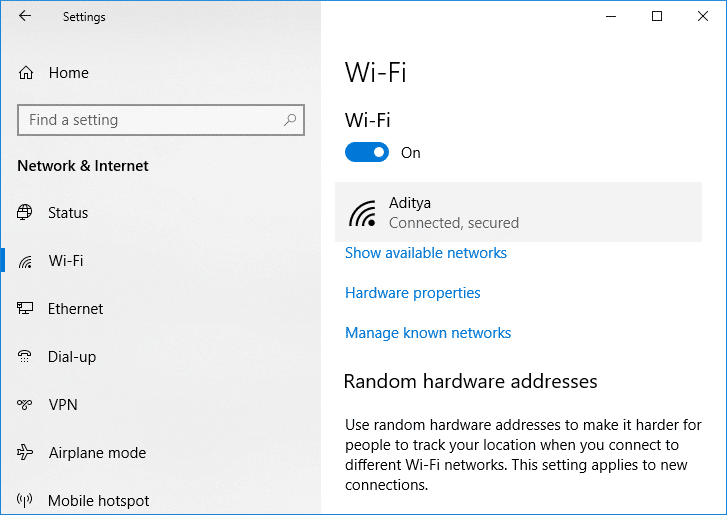
4. Scroll down to Metered connection and ngaktifake ngalih ing "Setel minangka sambungan meter".
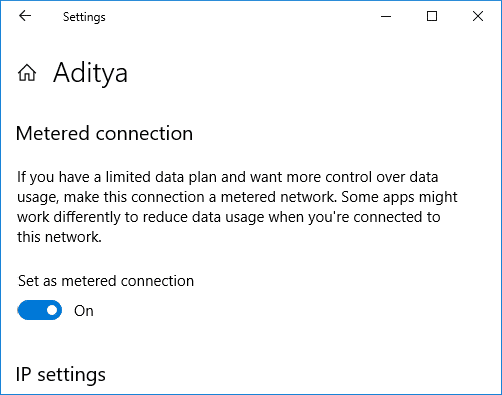
5. Close Settings and reboot your PC to save changes.
Recommended:
Wis, sampeyan wis sukses Fix Windows Modules Installer Worker High CPU Usage nanging yen sampeyan isih duwe pitakon babagan tutorial iki, aja ragu-ragu takon ing bagean komentar.
